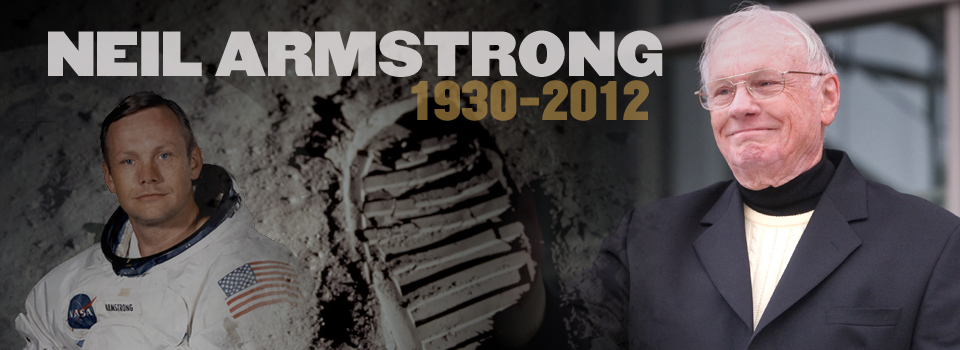Neil Armstrong: Humble hero, always a Boilermaker, always an engineer
Neil Armstrong: Humble hero, always a Boilermaker, always an engineer
| Magazine Section: | Always |
|---|---|
| College or School: | CoE |
| Article Type: | Issue Feature |
| Page CSS: | #armstrong-statue {
float: right; margin: 1em -200px 1em 1.5em; } |
| Feature Intro: | Millions were transfixed by the image of Neil Armstrong stepping foot on the moon July 20, 1969. The words he uttered, "One small step for [a] man, one giant leap for mankind," will forever be remembered. |
Armstrong died Aug. 25 nearly three weeks after undergoing quadruple heart bypass surgery. He was 82.
Born in his grandparents’ farmhouse in Wapakoneta, Ohio, Armstrong came to Purdue to study aeronautical engineering. He admitted to having been a nervous 17-year-old among an overflow of 20-something former combat veterans taking classes on the G.I. Bill.
Engineering faculty of the day were infamous for bellowing at freshmen that first day of class: “Look to your left and look to your right. Only one of you will be here next semester.”
Sixty years later Armstrong stood on stage in front of a building named in his honor with a sculpture in front depicting the young engineering student. “Only Purdue would put a statue of a scared freshman in front of an engineering building,” he remarked.
He received a bachelor’s degree in aeronautical engineering in 1955 and an honorary doctorate in 1970.
Called to duty
Armstrong attended Purdue on a Navy scholarship that required him to serve active duty before graduation. In his deployment, he flew 78 missions from an aircraft carrier during the Korean War and once had to parachute to safety after his plane hit a cable strung across a canyon.
His longtime close friend, fellow moonwalker and fellow Boilermaker Gene Cernan remembers Armstrong as someone who “embodied all that is good and all that is great about America.”
“Fate looked down kindly when she chose Neil to venture to another world and to have the opportunity to look back from space,” Cernan said. “No one … could have accepted the responsibility of his remarkable accomplishment with more dignity and more grace than Neil Armstrong.”
Always humble
Delivering the eulogy at Armstrong’s public memorial ceremony Sept. 13 in Washington, D.C., the Right Rev. Mariann Edgar Budde, bishop of the Episcopal Diocese of Washington, said that Armstrong didn’t bask in the limelight because he deeply believed he didn’t deserve it.
“This was not, I am convinced, an expression of Midwestern modesty, an attempt to minimize his passionate ambition,” she said. “It was simply the truth: No one goes to the moon alone. No one accomplishes anything of lasting value in any realm of human endeavor alone.”
Among the dignitaries attending the service was former U.S. Treasury Secretary John Snow, who recalled golfing with his friend. “You’d wait for him to putt. He’d survey the line to the hole. He’d measure the dew on the green,” Snow said. “You sometimes wondered, ‘Neil, are you ever going to hit the ball?’ He couldn’t help but be the engineer.”
On Aug. 27, more than 1,000 people gathered near Armstrong’s statue at Neil Armstrong Hall of Engineering for a memorial service. Tim Sands, acting president, told the crowd that Armstrong was always willing to talk to students. “He was passionate about encouraging young men and women to pursue careers in science and engineering.”
Leah Jamieson, the John A. Edwardson Dean of Engineering, echoed Sands’ remarks, saying, “He inspired us all. He would say that engineering is about ‘what can be’ and gave us unforgettable images of just how bold and inspiring the future can be. He was proud of being an engineer, and we have always been enormously proud that he was a Purdue engineer.”
A tribute to exploration
Befitting the man who first explored on the moon, the U.S. Navy has named the first of a new class of oceanic research ships the Neil Armstrong. The ship — the first of the Armstrong-class Auxiliary General Oceanographic Research (AGOR) vessels, is equipped with sonar to map the ocean floor and laboratories to conduct experiments.
The ship is currently under construction in Anacortes, Wash.


Comments